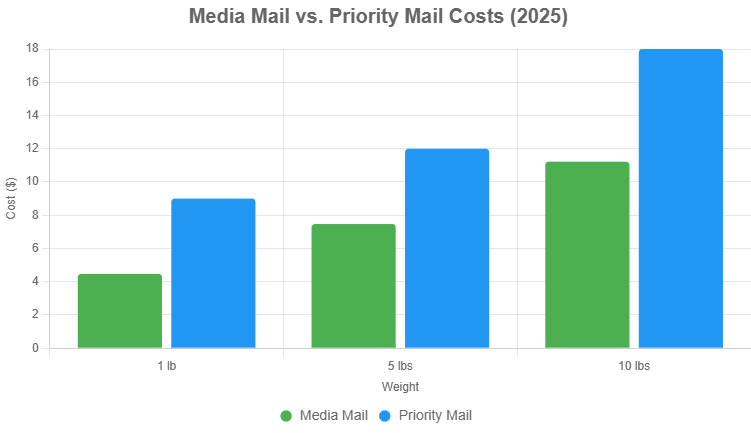This website uses cookies so that we can provide you with the best user experience possible. Cookie information is stored in your browser and performs functions such as recognising you when you return to our website and helping our team to understand which sections of the website you find most interesting and useful.
Everything You Need to Know About USPS Media Mail
Written by
NetizensMay 28, 2024
13 min read

Are you shipping your old vinyl collection to a friend or a stack of textbooks to a student? USPS Media Mail may be your best option if you want to save money, but only if you follow all of its rules! For a fraction of the price of other options, you can mail educational and cultural materials like books, CDs, and DVDs with this inexpensive shipping service. However, significant savings come with rules, delivery delays, and the constant threat of a USPS inspection.
Everything you need to know about Media Mail will be covered in this comprehensive guide, including what it is, what you can and cannot ship, current rates, how to use it, and advice on how to avoid costly errors. Continue reading to learn how Media Mail can help you save money and get your educational materials to the right place, whether you’re a student, librarian, or small business owner.
What is Media Mail? A Quick Overview
The United States Postal Service (USPS) offers a discounted shipping service called Media Mail that is intended especially for sending educational and informational materials. Consider printed music, books, CDs, DVDs, and even vintage 16mm movies. Students, teachers, and book resellers love it because it’s one of the least expensive ways to ship bulky items. However, there is a catch: USPS has stringent guidelines regarding what qualifies, and it is slower than other services.
During the Great Depression in 1938, the service was first offered as “Book Rate,” a New Deal initiative to encourage literacy by lowering the cost of mailing books. Despite financial difficulties at the time, the main goal was to get knowledge into people’s hands. In order to reflect its broader reach, which now includes educational charts, recordings, and more, USPS renamed it “Media Mail” in 1997. It is currently included in USPS’s Package Services, which offers discounted prices for qualified items but does not guarantee delivery time or the ability to open packages for inspection.
What makes Media Mail useful? For large shipments, it saves money, but you must be aware of all the details to prevent unpleasant surprises. Let’s examine what is allowed and what is not.
What Can (and Can’t) Be Shipped with Media Mail
Strict content guidelines accompany Media Mail’s affordable rates. Only educational or cultural materials are eligible, and USPS takes this seriously. They can check your package at any time to make sure it complies. Let’s break it down because sending the incorrect items may result in surcharges or returned packages.
What Qualifies for Media Mail
Here’s what you can ship with Media Mail:
- Books: Must have at least 8 printed pages of reading material or scholarly bibliography. Blank spaces for notations (like workbooks) are fine, but advertising must be minimal (e.g., book announcements).
- Films: 16mm or narrower positive prints in final viewing form, plus catalogs of films (24+ pages, 22+ printed). Not for commercial theater use.
- Printed Music: Bound or sheet music, like piano scores or guitar tabs.
- Test Materials: Printed objective tests for schools, assessing skills or aptitudes, with or without answers.
- Sound and Video Recordings: CDs, DVDs, vinyl records, even player piano rolls, including related guides or scripts.
- Playscripts and Manuscripts: For books, periodicals, or music.
- Educational Charts: Single-sheet references (e.g., periodic tables, math equations) for training or improvement. Narrative-heavy charts don’t count.
- Medical Loose-Leaf Pages: With binders, for doctors, hospitals, or medical students.
- Computer-Readable Media: Prerecorded disks with educational content and related scripts.
What Doesn’t Qualify
Don’t try to sneak these in, as they’ll get you in trouble:
- Video games, computer drives, or hardware.
- Magazines, newspapers, or periodicals (use First-Class or Periodicals mail).
- Comics, heavily illustrated novels (unless primarily reading matter), or advertising-heavy materials.
- Personal letters, bills, or non-incidental First-Class items.
- Anything intended for commercial use, like theater films.
Permitted Enclosures
You can include a few extras without breaking the rules:
- One bound envelope or addressed postcard (can double as an order form).
- One bound order form.
- Up to three book announcements with order forms.
- Incidental First-Class items like invoices or personalized greetings, as long as they’re related and minimal.
- Written additions like sender info or handling instructions (but not full letters).
Inspection Warning
USPS can open Media Mail packages to check contents. If you include non-eligible items, you risk paying higher rates (like Priority Mail) or having your package returned. Always double-check your items before shipping, just like you’d double-check before hitting send on an important email. (If you ever need to undo a sent message, here’s how to unsend an email in Outlook effectively.)
| Eligible Items | Non-Eligible Items |
|---|---|
| Textbooks (8+ pages) | Video games |
| CDs/DVDs | Magazines |
| Printed music | Comics |
| Educational charts | Personal letters |
Media Mail Rates and Pricing
The affordability of Media Mail is one of its main selling points. It is perfect for heavy packages because, in contrast to other USPS services, rates are only determined by weight (up to 70 lbs) and not by distance. The price of single-piece retail Media Mail as of October 2025 is as follows:
| Weight (lbs) | Rate ($) |
|---|---|
| 1 | 4.47 |
| 2 | 5.22 |
| 5 | 7.47 |
| 10 | 11.22 |
| 20 | 18.72 |
| 50 | 41.22 |
| 70 (max) | 56.22 |
You can see why Media Mail is a great deal for bulky books when you contrast that with Priority Mail, which starts at $9+ for a 1-pound package! If you’re shipping in large quantities, check with the USPS as permit imprint may offer cheaper rates for commercial or bulk mailers. Rates were slightly reduced for certain weights in July 2025, but always check USPS for the most recent price.

How to Use Media Mail: Step-by-Step Guide
Ready to ship with Media Mail? Follow these steps to ensure a smooth process and avoid costly errors.
- Verify Content Eligibility: Double-check that your items meet USPS guidelines (see above). Mixing in non-eligible items like magazines or video games could lead to surcharges.
- Package Securely: Use sturdy boxes or padded envelopes to protect contents. Avoid rigid items like poster tubes, which can jam USPS sorting machines and cause delays.
- Label Correctly: Write “Media Mail” clearly on the address side of your package. Include full delivery and return addresses with ZIP Codes.
- Add Optional Services: Media Mail doesn’t include tracking by default. Add Certified Mail ($4.40) or Electronic USPS Signature Confirmation ($3.65) for basic tracking. Insurance (up to $5,000, starting at $3.75) is also available for loss or damage. For those who frequently send documents or run online stores, choosing one of the best email providers can also streamline your communication and delivery confirmations digitally.
- Visit the Post Office or Use Online Tools: Drop off your package at a USPS location, or schedule a pickup via USPS. You can also print labels online for convenience.
- Expect Delivery: Plan for 2–8 business days, though 5–7 is common. Media Mail is low-priority, so delays can happen, especially during holidays.
- Weigh your package accurately and round up to the nearest pound.
- Keep receipts as proof of mailing for future reference.
- Leave packages unsealed for USPS inspection if required.
Pros and Cons of Media Mail
Is Media Mail the right choice for you? Let’s weigh the benefits and drawbacks.
Pros of Media Mail
- Cost-Effective: Save big on heavy shipments (e.g., 20 lbs for ~$18 vs. $50+ for Priority Mail).
- Supports Education: Designed to make knowledge accessible, perfect for students and libraries.
- Simple Pricing: Weight-based rates with no zone complications.
Cons of Media Mail
- Slow Delivery: Expect 2–8 days, often leaning toward the longer end with no guaranteed timeframe.
- No Default Tracking/Insurance: You’ll need to pay extra for these services.
- Strict Rules: Non-eligible items or improper packaging can lead to inspections and penalties.
Common Pitfalls and How to Avoid Them
Media Mail is great, but it’s easy to mess up if you’re not careful. Here are common mistakes and how to steer clear:
- Pitfall 1: Ineligible Items
Problem: Shipping magazines, video games, or comics thinking they qualify.
Solution: Review USPS’s eligible items list on USPS before packing. - Pitfall 2: Expecting Fast Delivery
Problem: Assuming Media Mail is as quick as Priority Mail.
Solution: Plan for 5–7 days and add tracking (e.g., Certified Mail) for peace of mind. - Pitfall 3: Poor Packaging
Problem: Using flimsy boxes or rigid tubes that jam sorting machines.
Solution: Opt for sturdy boxes or padded envelopes to ensure safe transit. - Pitfall 4: Inspection Surcharges
Problem: Including non-eligible items, leading to reclassification at higher rates.
Solution: Label as “Media Mail” and ensure contents strictly comply.
Real-World Example: A small business owner was fined when USPS found comics in a Media Mail package, recharging it at Priority Mail rates—a $20 mistake on a 5-pound shipment!
Alternatives to Media Mail
Media Mail isn’t always the best fit. Here are other options for different needs:
- USPS Ground Advantage: Delivers in 2–5 days, slightly more expensive but great for non-educational items or faster shipping. Includes basic tracking.
- Priority Mail: Guaranteed 1–3 days, ideal for time-sensitive or valuable items, starting at $9 for 1 lb.
- UPS/FedEx Ground: Competitive for heavy packages, often with better tracking and reliability for commercial needs.
Similarly, if you run a small business that regularly ships educational materials or promotes courses, leveraging one of the best email marketing services can help you reach your audience digitally while you handle your physical shipments smartly.
When to Choose Alternatives: Use these for urgent shipments, non-qualifying items (e.g., magazines), or when you need guaranteed delivery. Compare costs and speed to decide.
Is Media Mail Right for You?
For affordable shipping of books, CDs, DVDs, and other educational materials, Media Mail is an excellent option. For heavy packages, its weight-based, low rates make it the best option; however, the trade-off is strict content rules and slower delivery (2–8 days). You can save a lot of money and avoid hassles by carefully packing, adhering to USPS regulations, and anticipating any delays.
Ready to ship those textbooks or vinyl records? Use our step-by-step guide to pack and send your Media Mail package like a pro. For the latest rates and rules, check USPS. or use the USPS Price Calculator. Happy shipping, and keep spreading knowledge affordably!
FAQs
1. What qualifies for USPS Media Mail?
2. How long does USPS Media Mail take to deliver?
3. Can I track a Media Mail package?
4. What happens if I ship non-eligible items with Media Mail?
5. Is Media Mail worth it for heavy packages?

Let's Start Your Project
Get free consultation for your digital product idea to turn it into reality!
Get StartedRelated Blog & Articles

Netizens
June 18, 2024
How Zapier Can Streamline Your Workflow in 2024
Feeling bogged down by repetitive tasks between your favorite apps? Enter Zapier, a popular automation tool

Netizens
May 3, 2024
Top Enterprise SEO Solutions to Dominate Search Rankings in 2024
In the competitive digital landscape, businesses need robust strategies to enhance their online visibility and drive

Netizens
May 17, 2024
Building Apps with the MERN Stack
The MERN stack is a popular choice for web development, combining four powerful technologies: MongoDB, Express.js,




